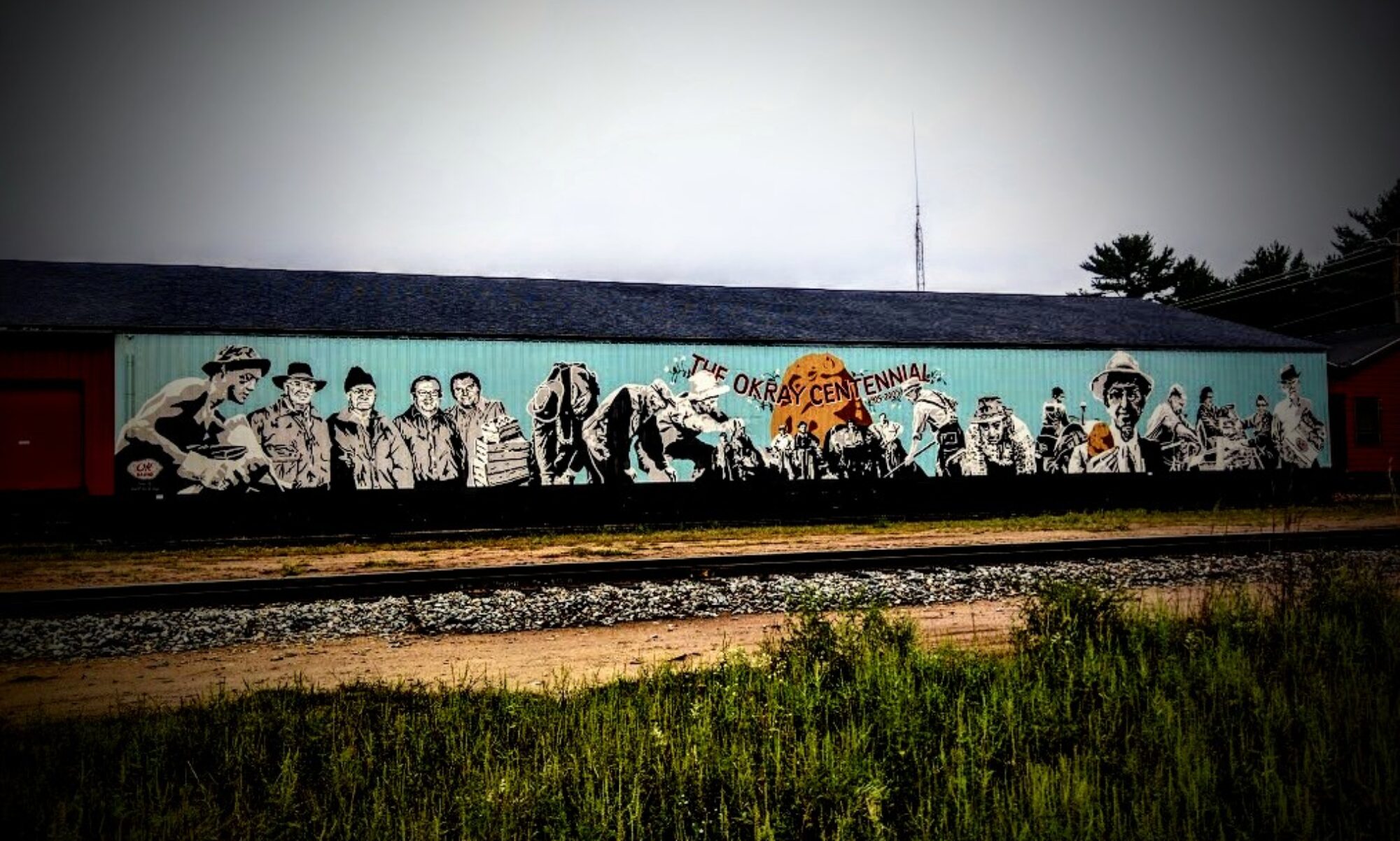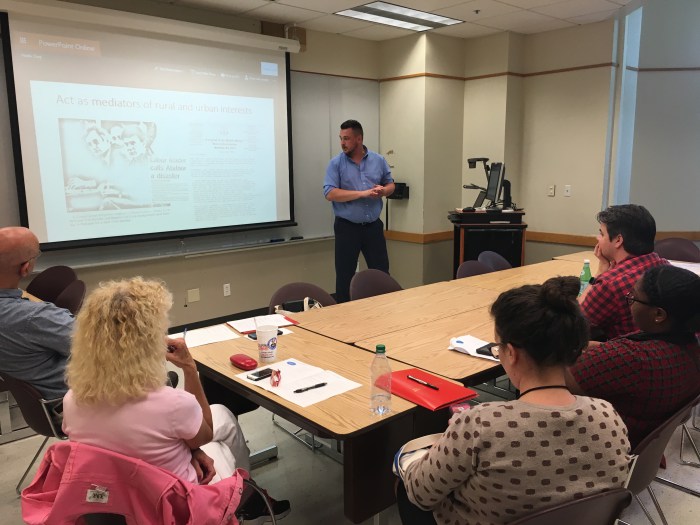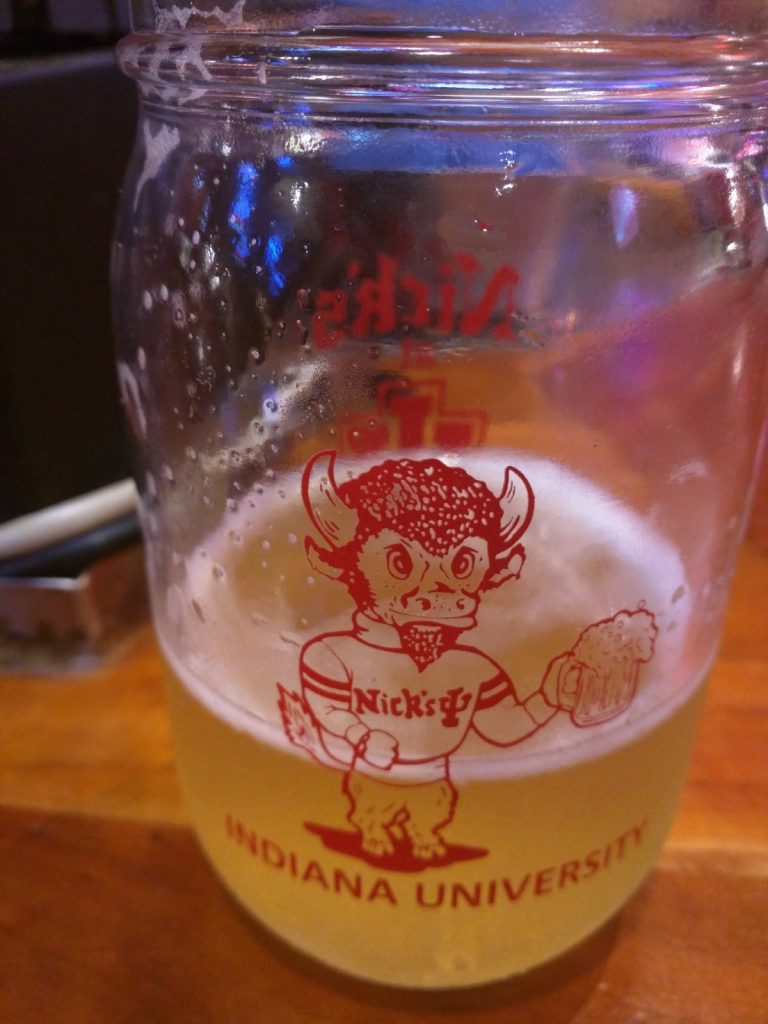Alternatively titled: Keeping Up A-Pierre-ances
Having just returned from a brief trip to Dallas, I was in Minnesota long enough to do some laundry, spend a half-hour with my mom on Mother’s Day, get a few camping supplies, pack up the car, and catch four hours of sleep before I left for Pierre at 5am on Monday the 15th. The drive across western Minnesota and South Dakota was not nearly as painful as I made it out to be, aided in part by the beauty of the Minnesota River Valley and the excitement of a detour around Watertown which led to a necessary pit stop in Goodwin, SD (population: 146), at their lovely town park’s outhouse.
As I lacked the time to stop by my campsite and decompress (it was already 12pm as I rolled into Pierre), I drove straight up to their beautiful Cultural Heritage Center, which looks like none other in the Midwest:
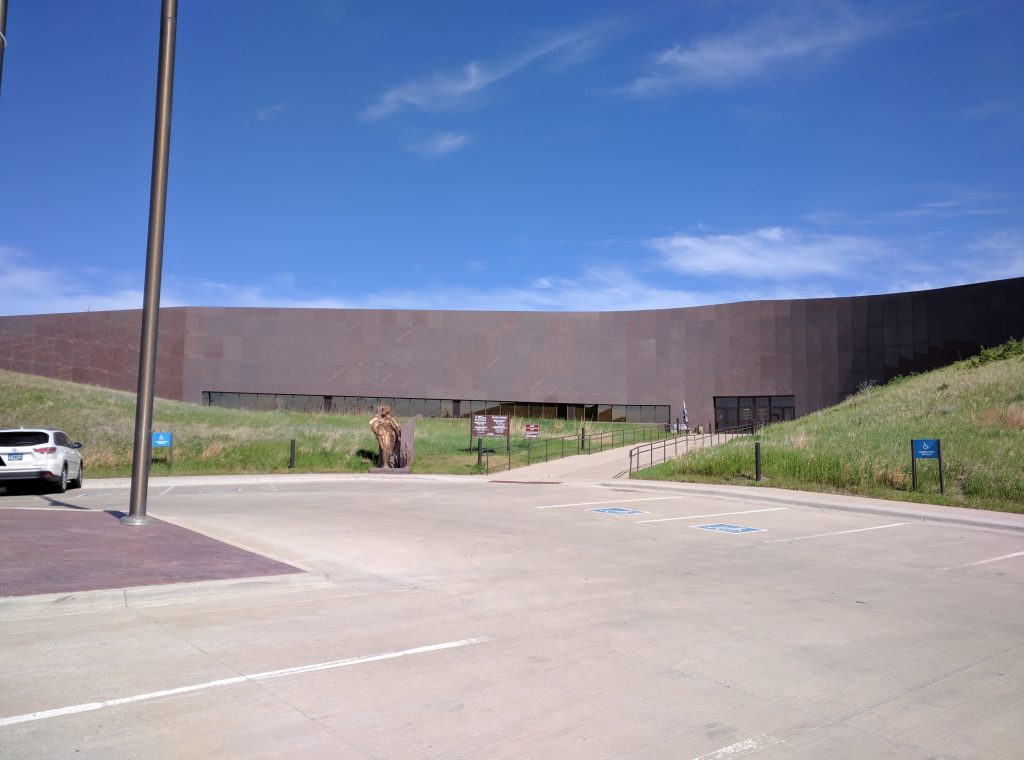
The Research
Collections:
Abdnor Papers
Office of the Governor Papers, Harvey Wollman
Democratic Forum
Observations:
Abdnor in 1980 vs. 1986: Thumping incumbent and prairie populist paragon (I couldn’t resist) George McGovern by nearly 20 points in 1980, Abdnor joined the ranks of first-term senators signaling the Reagan Revolution across the heartland and America writ large. That ability to strike against the established, career record of McGovern–especially on his “national liberalism”–was coupled with a ton of PAC money targeting Abdnor and five other “vulnerable” senators (Gaylord Nelson and Birch Bayh among them) for defeat. By the time McGovern went on the offensive and attacked Abdnor’s record while defending his own, the damage was long done.
In 1986, though, South Dakota’s at-large representative Tom Daschle had a running start in decrying the outside money pouring into the state (though naturally he’d accepted external money as well). Much quicker than McGovern–and perhaps with a little help from McGovern, who founded an organization designed to combat national conservative PAC money right after his 1980 defeat–Daschle struck back against those people attacking him on “conservatives'” behalf, running on his record of defending South Dakota’s interests as their lone representative in the House. It proved much harder for Abdnor to pin on Daschle lines like he’d pinned on McGovern’s inability to get a pheasant hunting license: “It proves he’s not in South Dakota very much.”
Daschle’s Populism: Abdnor’s campaign could not get anything to stick to Daschle in the lead-up to the 1986 Senate elections. Missed a vote because he was fundraising in Miami? Didn’t stick. Slippery on the abortion issue? Daschle noted his personal opposition to abortion and talked his way around his own votes. No, what stuck with Abdnor was the Farm Bill vote in 1985, and Daschle made sure he was constantly touring South Dakota, especially the counties around Rapid City and the northeastern quadrant of the state, highlighting the plight of the family farmer.
Perhaps most significant was a February 1985 tour of the state Daschle took, essentially a pre-campaign campaign as Congress was preparing to vote on a Daschle-sponsored bill which would have provided farmers nearly $2 billion in loan guarantees, another $100 million in interest rate subsidies, and commodity price support up front (before the harvest). He visited towns like Parkston and Lake Preston, allowing farmers to vent and be heard. All the while, he made sure to point to the intractability of the Reagan Administration’s farm policy. Reagan’s veto of the bill (which he deemed a “bailout”) and the continuation of debt-restructuring policy under Ag Secretary John Block marked a clear distinction: Daschle and the farmer vs. Reagan and Abdnor. Daschle then got a whole year and a half to hammer that point home.
The Farm Alliance Rally, and South Dakota goes to Washington: I had read a lot about the South Dakota Farm Alliance Rally, held at Pierre’s Riggs High School and followed by a march to the State Capitol on Tuesday, February 12, 1985. Buses of angry farmers from all over the state descended on Pierre, where they listened to around 20 speakers[1] who bemoaned the Farm Crisis, challenged the South Dakota Legislature and Congressional delegation to take action, and viciously attacked Secretary of Agriculture John Block, Director of the Office of Management and Budget David Stockman, and the credit policies of the Farmers Home Administration (FmHA). This rally spurred the South Dakota Legislature and Governor Bill Janklow to pass a bill sending the entire legislature to Washington, D.C. to meet with congressmen and, hopefully, President Reagan.
A few things things I learned: Before the rally, a Watertown farmer, Ron Hetland, had gone on Watertown’s KWAT radio station and suggested a “Give a Buck” project in which South Dakotans of all stripes would donate $1 to defraying the legislators’ travel costs. The project took off, and eventually even Speaker of the House Tip O’Neill was writing a $1 check to the cause![2]
It hadn’t occurred to me until I actually visited Pierre: 6,000 people descending on this city would be madness. Pierre, then a city with just over 12,000 residents, would have been flooded by citizens taking to the streets in favor of immediate legislative action. If I had been skeptical in the past, visiting here certainly convinced me of the event’s magnitude. Someday someone will write an article on the social-political history of South Dakota, February 1985, and I will read the heck out of it. There have to be oral histories galore just waiting to be collected.
The 1986 Election, Primary and General: Jim Abdnor tried to run one wicked gauntlet amid a terrible economic crisis and mounting frustration with the Reagan Administration. He was challenged in the primary by term-limited Governor “Wild Bill” Janklow, then met popular Democrat-in-a-Red-State Rep. Tom Daschle in the general election.
The primary was a knock-down, drag-out affair, but Abdnor’s experience won the day over Wild Bill’s typical shoot-from-the-hip style. The Abdnor campaign targeted Janklow for, among things, helping force the resignation of the South Dakota State University dean (if not orchestrating it himself), suddenly lavishing spending on projects like parks on constituents, and generally lacking the temperament to represent the state in Washington. One notable criticism was how he handled budgets: in internal memos Abdnor’s staffers would note to one another that while Janklow could effectively snap his fingers and cut 5% from the state budget, in Congress he would have to negotiate that cut with fellow legislators–not an easy task. Incumbency reigned; Abdnor dispatched Janklow by a 54-45 margin, with his biggest wins coming in West River counties.
Abdnor’s showing in the general election surprised pundits, only losing by about 3%. His attempts–and the attempts of outside PAC money, which both sides used liberally–to stick the “pro-choice” label to Daschle generally failed to gain major traction, though, as agricultural concerns won the day. Abdnor could not explain away his vote in favor of the Farm Bill of 1985, and his close ties to the Reagan Administration hurt him at the polls in November.
The City
Lodging
Farm Island Recreational Area: Minus an early Tuesday rainstorm blowing half my tent over on me (it’s more fun re-pitching a tent at 5am in driving rain anyways, right?), what a great place to camp. I was virtually alone–save for one family and one enterprising raccoon–in the East section of the campground, meaning I could stretch out, relax, and enjoy the peace and quiet:
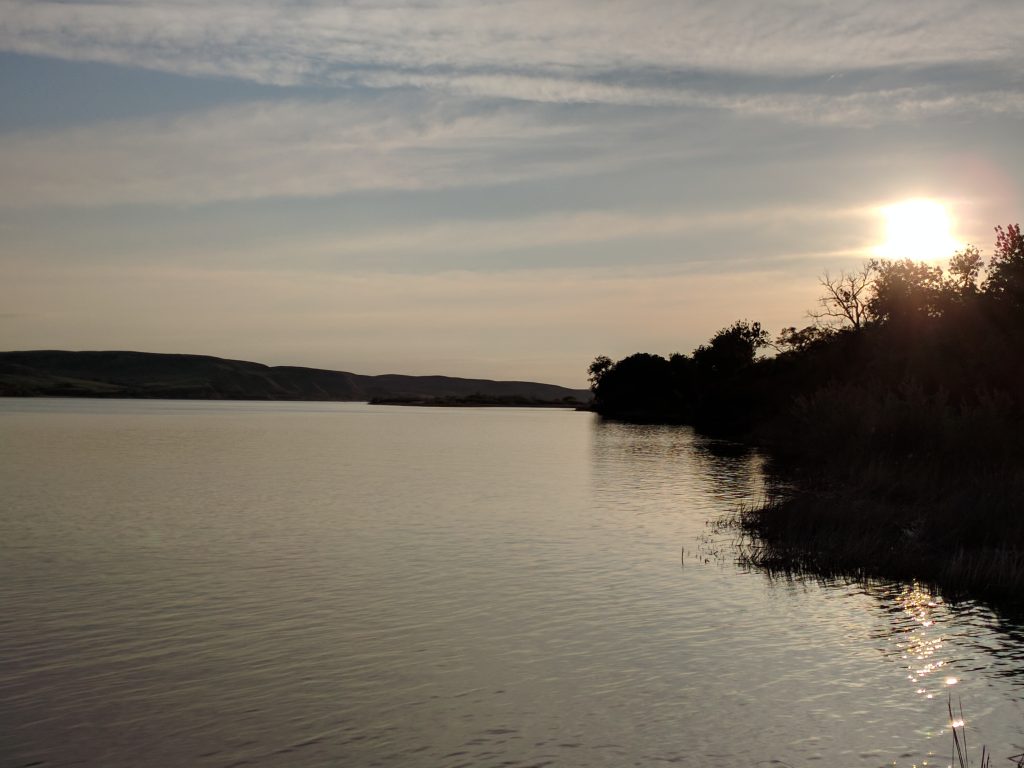
Sightseeing
Since the archive was open only from 9am-4:30pm every day, I had adequate time to get out and explore Pierre, in addition to a little R&R&R (rest and relaxation and reading, the graduate student’s curse) at the campsite. If you like being outdoors, Pierre is a great city to do that in.
Lewis & Clark Trail: I was able to take a couple 10-mile rides down the Lewis and Clark Trail to the bridge connecting Pierre with Fort Pierre and back to Farm Island. I feel like I got the full Pierre experience in that short time: biking not 150 yards from a gun range (which I thought was fireworks, stupidly), past scenic views of the Missouri River, and eventually right by a Little League game where the right fielder was separated from the Missouri by the fence, about 10 feet of bike path, and maybe another 20 feet of grass before the river! That’s a heck of a view.
For the novelty, I also biked over the bridge to Fort Pierre, going back in time (they’re on Mountain Time) before losing an hour and heading back to the campsite. Despite spending only 10 minutes in the past, I still felt like something was taken away from me.
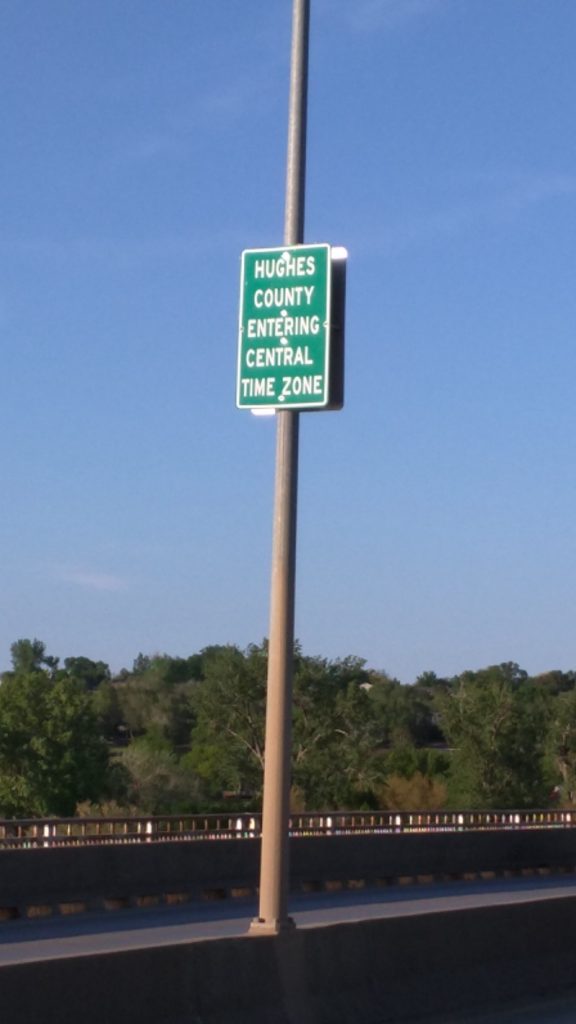
The Exchange: I needed a place to do some writing during the mornings (especially after I woke up with half my tent on my head on Tuesday morning), and it turns out a new coffeeshop just opened up in Pierre. This has apparently been quite the novelty for residents of Pierre (Pierrans? Pierrites? I forgot to ask), as it’s the first of its kind–as far as I could gather–in the city.

The Capitol (and Grounds): A friend from Marquette and a Pierre native, Eric Titze, had regaled me with stories of stopping in the Capitol on his training runs while a member of the track team at Riggs High School, and I could see why. The South Dakota Capitol Building is incredibly accessible–public parking spots line the curbs not 20 yards from any door. The building itself struck me as similar to other capitol buildings–cupola, wood paneling, roll-top desks–but with a very open, forthright charm.
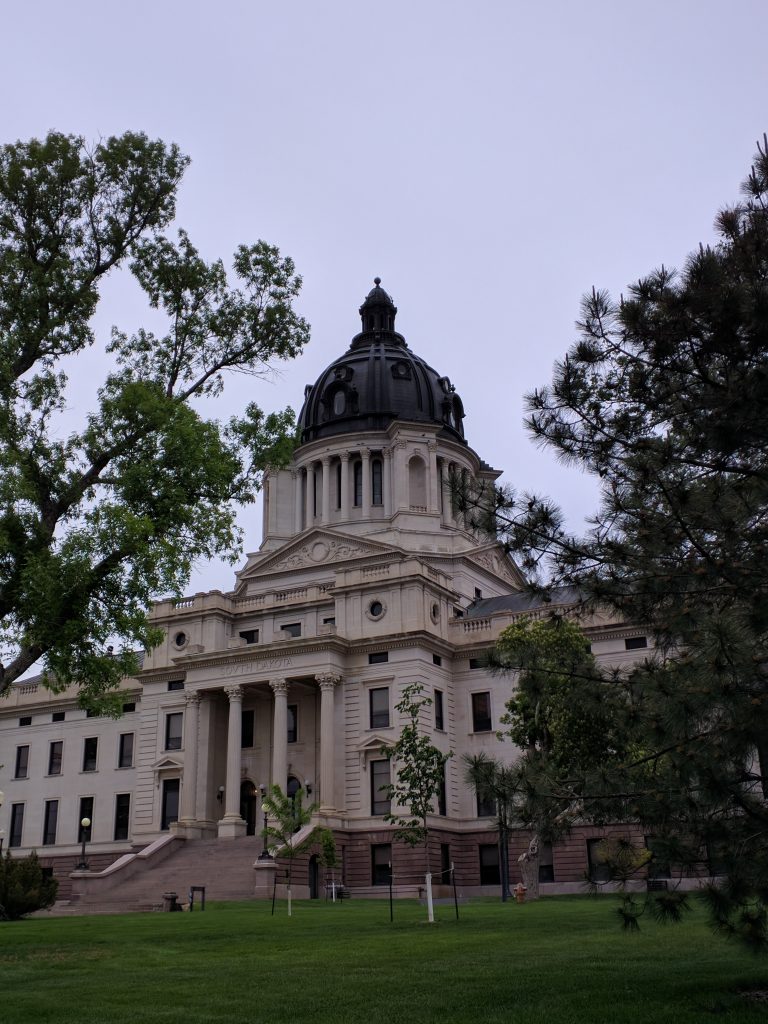

The Beer
Putting it lightly, Pierre is a beer desert. If you’re visiting here and looking to pick up some craft beer, you’ll be able to find about 7-10 major craft beer companies (I do not count Sam Adams or Blue Moon in this group): Crow Peak (Spearfish, SD); Summit (MN); Surly (MN); Boulevard (KS), but just their Unfiltered Wheat; Tallgrass (KS); Black Tooth (WY); and Deschutes (OR) come to memory. And that’s…that’s about it. No store (save for Lynn’s DakotaMart) I visited had a selection wider than about 6, and therein it was usually just 1-2 varieties of each beer. So if you’re picky or really have your heart set on drinking something quasi-exotic (and I’m just talking about a gose–forget finding that imperial coffee stout brewed with vanilla beans), bring it from outside.
There was, however, a bright spot! On Wednesday, with the weather looking ominous, I headed up to North Ridge Mall and checked out Bill of Rights Brewery. Brian, the owner and brewer, was tending bar and offered up his thoughts on brewing and distributing in South Dakota, as well as a flight of his four offerings.
We’ll do the fun stuff first: He’s brewed four solid ales (no lagers right now, he says) that each bring something different to the table. The IPA was a pretty standard, very bitter offering, nothing that I’d be back for but a fine-drinking beer. Fans of ginger will definitely enjoy the Lady Liberty ale, a ginger-spiced ale that’s easy-drinking at just 4.8%. (I’m not wild on ginger, but the ale itself was quality and worth a look if that’s your thing.)
Brian offered that the Bear Arms Brown Ale (in addition to having a great name, I thought) was easily the most popular of his four beers, and I could see why. It had a nice chocolatey profile, but also a toasty nuttiness that complimented it. I don’t know of too many Midwestern microbreweries that count a brown among their flagships, and this one was worth it.
My favorite, though, was the 1st Amendment ale, brewed with local Black Hills honey and basil. Despite being 6%, it was a crisp, drinkable ale with a really intense flavor profile. The sweetness of the honey on first taste gave way to a spicy basil finish, reminding me of exactly what I love about Great Lakes Distillery (MKE) and their Rehorst Gin. I hope Brian enjoys a ton of success–not just because of the beer, but because he was wonderful conversation for the 30 minutes I spent at the bar alone, talkative after a day in the archives–and is able to can these beers soon.
…that appears to be tough in South Dakota, though, until legislation governing the distribution and sale of beer changes. Brian relayed his frustration that he could not even “walk across the street and sell a barrel to that restaurant” because in South Dakota he is required to sell his beer through a distributor. Apparently, even at a local tasting event he was not allowed or supposed to pour his own beer because he is the proprietor of the brewery but not at the brewery itself. Hopefully he’s able to use his standing in Pierre to lobby the legislature, because with the explosion of Brewer’s Row in Sioux Falls and good beer popping up all over the state, some of us across state lines would enjoy a can or two of South Dakota craft beer!
What’s Next?
Next (this!) week I’ll be based out of Saint Paul, perhaps making a day trip to UW-Eau Claire, UW-Stout, or Saint Cloud State University to check up on some of the Democratic losers from the 1980s, all before I turn my attention back to the Minnesota Historical Society archives and the tensions from the left and center which had not been fully resolved from the Minnesota Massacre of 1978.
[1] No, really! A Woonsocket News article from 2/7/85 lists them as “Pierre Mayor Grace Petersen, South Dakota Rural Electric Association President Maurice Bergh, South Dakota Retailers Association Executive Director Dean Randall, South Dakota Education Association President Dianna Miller, Catholic Rural Life Conference Director Father Leonard Kayser, South Dakota Federation of Labor AFL-CIO President Jack Dudley, South Dakota Chamber of Commerce Executive Director Dave McNeil, Mitchell Schools Superintendent Dennis Peterson, South Dakota Farm Borrowers Association President Bill Bullard, and South Dakota State University President Dr. Ray Hoops.” After them, Gov. Janklow, Sens. Abdnor and Pressler, and Rep. Daschle all spoke, as did Democratic leaders Roger McKellips and Lars Herseth. National Farm Organization President Ken Eckmann provided closing remarks.
[2] Editorial, “This trip to Washington,” Watertown Public Opinion, 7 February 1985, p. 4.
